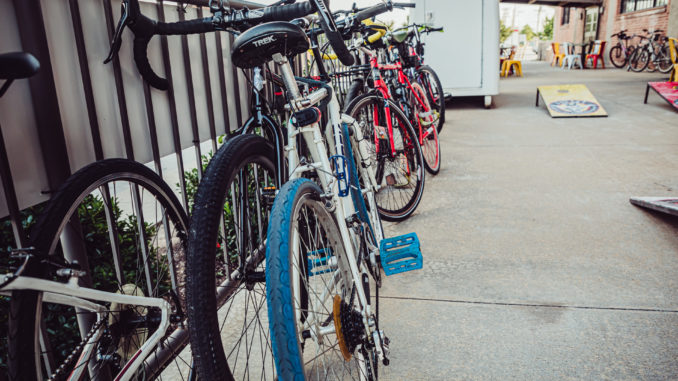
Imagine that you have recently invested in an expensive road bike. You even bought the spandex shorts, clip-in shoes, and funny-looking cap. Even though you totally look the part, are you really ready to hit the road?
Don’t get me wrong, road cycling is a fun way to stay fit and a great form of transportation. However, similar to driving, the responsibility of being on the road isn’t without some risk. For anyone sharing the road, understanding state statutes and proper cycling etiquette may minimize that risk. These suggestions are not to limit you, but to ensure safety for everyone on the road.
The first thing for a cyclist to ponder before hitting the road is that bicycles in the roadway are considered vehicles. Therefore, cyclists should ride responsibly and behave like a motorist by obeying all traffic signals and signs.
Ride on the road.
Sidewalks are meant for pedestrian use only. In essence, riding your bike down the sidewalk is the same as if you hopped the curb and started to casually drive down it in your car. Having a bike lane for commuter cyclists is important for several reasons.
Bike lanes are a good thing.
The added lane promotes a more orderly flow of traffic; allowing faster moving vehicles a safe enough space to go around and reduces delay for drivers. Bike lanes make crossing pedestrians more visible to drivers and remind drivers to watch out for cyclists. Having a lane for bikes also increases clear space between parked cars and moving vehicles and provides a buffer for pedestrians between sidewalks and through traffic.
Go with the flow.
Ride in the same direction as traffic and try to ride at a safe speed that matches the flow of traffic. Be mindful if you are cycling at a slower speed than traffic in an area without a bike lane. Try to stay nearer to the right side of the road to allow other vehicles to pass you on your left.
Prepare for weather conditions.
Bad weather conditions such as rain, fog, wind, snow, or ice can make cycling and driving dangerous. This poses a risk for anyone on the road.
Beware of hazards.
Difficult road conditions such as sharp curves, busy intersections, uneven surfaces, or obstacles in the road can lead to accidents. Reckless drivers also create a hazardous environment for others sharing the road. Being aware of your surroundings is a solid way to prevent accidents from occurring.
Use hand signals.
Hand signals while road cycling are the equivalent to motorists using a blinker. The indicator communicates to other motorists and non-motorists that you wish to turn, switch lanes, etc.
Slow down and stay safe in school zones.
Watch for crossing guards and kids walking to and from school. Yield to pedestrians and other vehicles already on the road outside of school zones as well.
Use lights and reflectors.
Not only does adding lights to your bike improve your visibility, it also makes you more visible to everyone else on the road. Use lights such as rear reflectors, a white light on the front of your bicycle or a strobing red light on the tail of your bike to grab the attention of a driver approaching from behind. If you’re a commuter, here is a list of protective gear to also consider while cycling.
Wear a helmet.
Protecting your head should be priority number one no matter the length of your trip. Collisions can happen to the most experienced cyclists. Wearing a helmet is quintessential for cycling safety and can prevent head injuries if an accident were to occur.
High-visibility clothing.
Reflective clothing or bright, neon colored clothing makes you more noticeable. High-visibility clothing essential while riding at night and can help you be seen when daylight is limited.
Bike bell.
Adding a bell or other audible feature can prevent accidents by alerting others who might be blocking your lane of travel. The bell can also notify others when you are hard to see during poorly lit times of day or dim areas in town.
Use mirrors.
Mirrors come in handy in times when you might not be able to turn your head to look over your shoulder for oncoming traffic. For anyone who travels in urban areas, a helmet mirror or handlebar mirror may give you advantage to avoid dangerous situations.
Take off the headphones.
Biking through town without headphones allows you to be more aware of your surroundings. Not having the ability to hear emergency vehicles or those trying to communicate to you on the roadway is hazardous.
The majority of bike related accidents happen due to unsafe riding. For cyclists and motorists, both beginners and veterans, the rules of the road are often neglected or misunderstood. With the growing number of commuting cyclists, bike lanes and trail building in the Joplin area, it is critical to follow traffic laws and etiquette while biking to avoid putting yourself and others at risk. By being a responsible rider and obeying and minding the rules of the road, risk perception and hazard awareness, you have the ability to prevent accidents and to create a safe experience for anyone commuting in town.
To learn more about road cycling safety and traffic laws for the state of Missouri go to www.modot.org/bicycle-and-pedestrian-links for a list of useful links of resources for bicyclists and pedestrians.







Be the first to comment